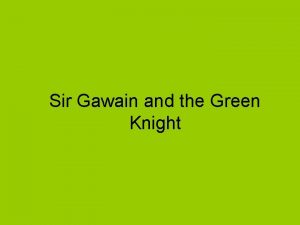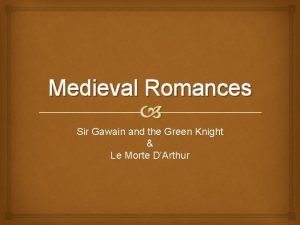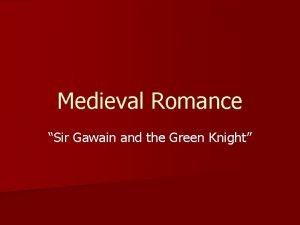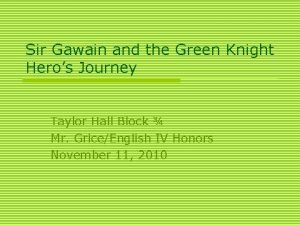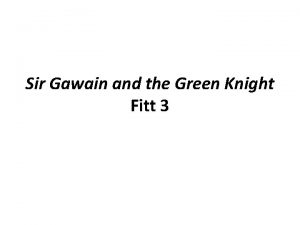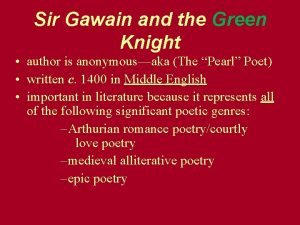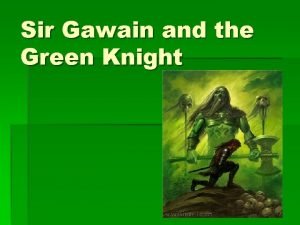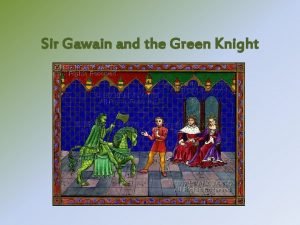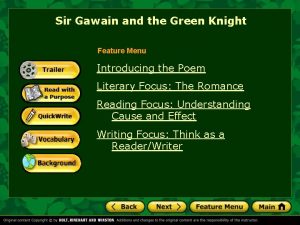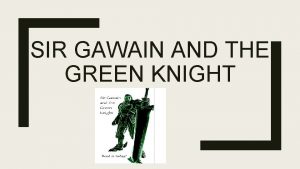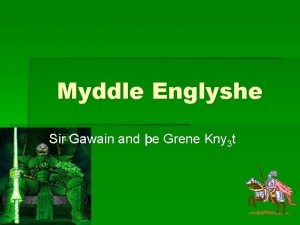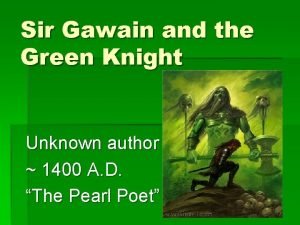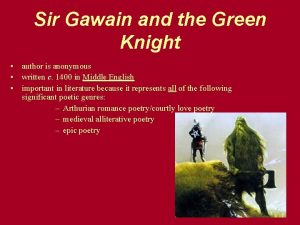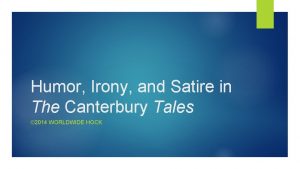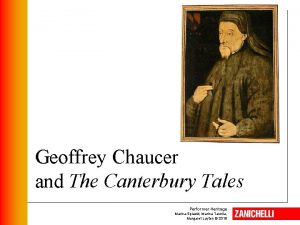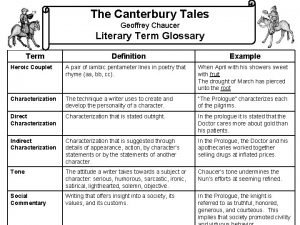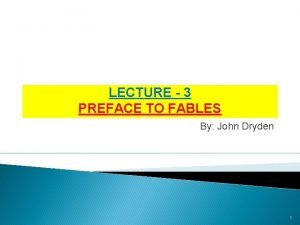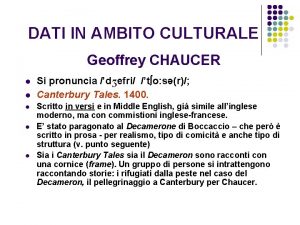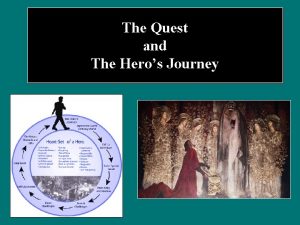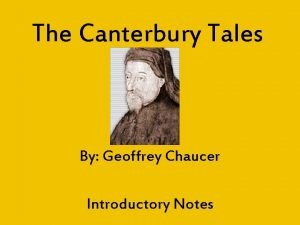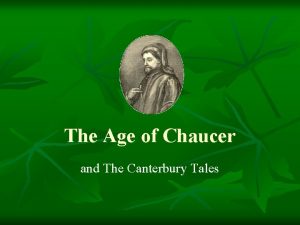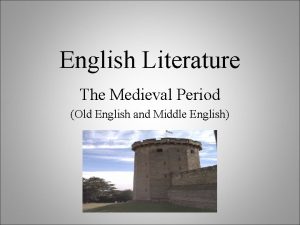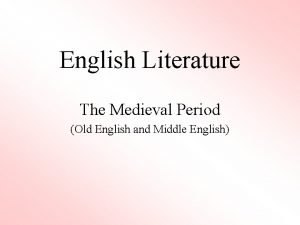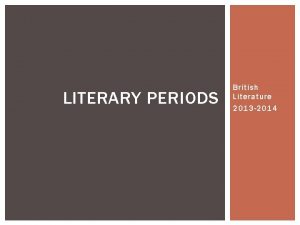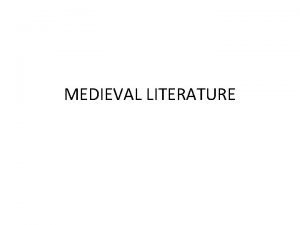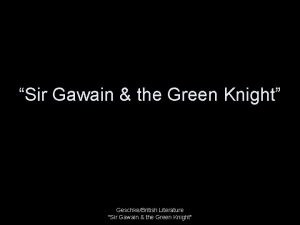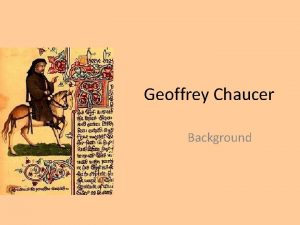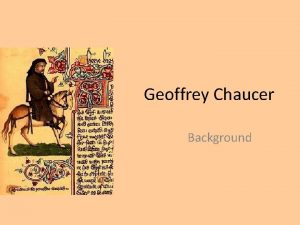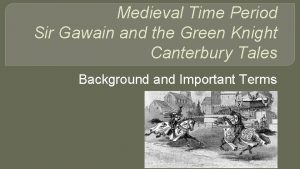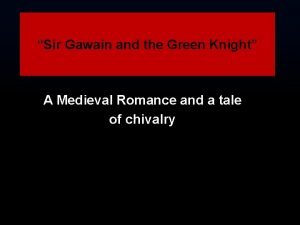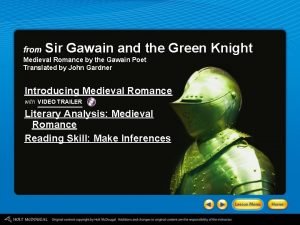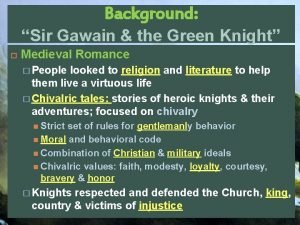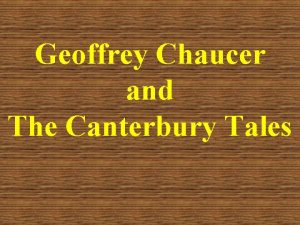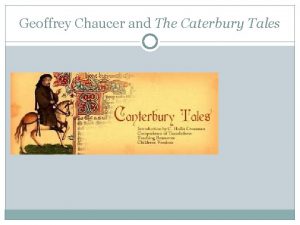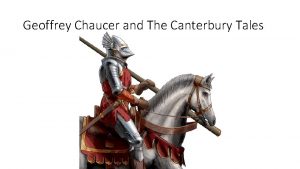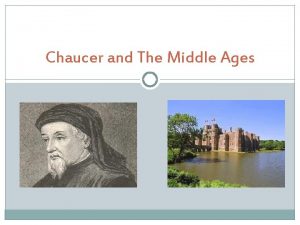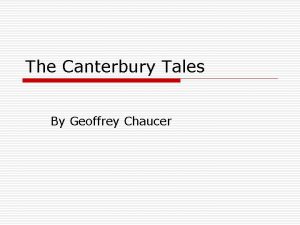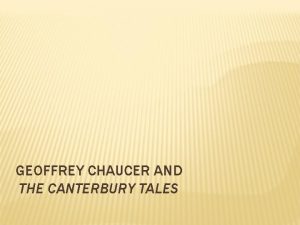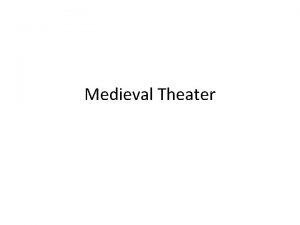Medieval Literature Chaucer and Sir Gawain and the































- Slides: 31

Medieval Literature Chaucer and “Sir Gawain and the Green Knight”

“The Canterbury Tales” by Geoffrey Chaucer “The Prologue” “The Pardoner’s Tale” “The Wife of Bath’s Tale”

I Learning Targets • I can define and analyze direct and indirect characterization and how they influence tone. • I can define and analyze social commentary.

CHARACTERIZATION - the act of creating or developing characters DIRECT- author outright tells the reader a character’s traits The Knight “followed chivalry, / Truth, honor. . ” I am having so much fun studying for my midterms! • • • INDIRECT- author shows… through character’s actions character’s thoughts/feelings character’s words/speech character’s appearance other characters’ observations/reactions (requires reader to put together the clues) “[The knight] was not gaily dressed, ” implies that the Knight doesn’t care about appearances and, in fact, might have come straight-away from the battlefield. This indicates a seriousness of purpose for the Knight.

Define • Tone: author’s attitude toward a character, event, or idea • Social Commentary: author’s comments on aspects of society

Frame Warm-up • A story that brackets or frames another story or group of stories. • The story-within-a-story, so to speak. • How might The Prologue frame the upcoming tales? • How does Chaucer define his purpose at the beginning of The Prologue? • I can define and explain Chaucer’s use of the frame.

Stereotype warm-up

Stereotype warm-up

Vocab. Warm-up 1 Write 3 vocab. sentences that summarize character: • solicitous w/ friar • largesse w/ knight • adroit w/ yeoman

Social Commentary • Squire (Podrick Payne @ large): He could make songs and poems and recite, knew how to joust and dance, to draw and write. • Medieval chivalric training included lessons in music, poetry, and drawing, as well as the martial arts. A knight-in-training was expected to be a man skilled in culture and courtesy. (also Medieval culture)

Social Commentary • Nun: courtliness, stately bearing, golden brooch Image by National Museum in Warsaw • 14 th century social etiquette allowed (even demanded) that a prioress display courtly manners, dignity, and wealth (also Medieval culture).

Social Commentary • Monk: skill and pride in hunting; fine gray fur; wrought-gold pin by en: Aldobrandino of Siena - France • “In the modern world’s more spacious way, ” the old ascetic religious ideal was passing away in favor greater materialism and worldliness (also tone).

Military • Knight • Squire • Yeoman The Canon's Yeoman in the Ellesmere manuscript of Geoffrey Chaucer's Canterbury Tales.

Religious sect • • Nun (Priests, Nun #2) Monk = hunter with the duds What A Monk Should Be Friar = listened to confessions and absolved sin for a fee Pardoner = dispense pardons from the Pope Summoner = serves summons for the church courts Parson = (Middle English persone from the Latin persons or Parish priest)

Vocab. Warm-up 2 • Select 2 vocab. words that share a relationship. • Explain how they’re related. • Consider 2 modern day or medieval careers in which the words would be utilized. • Write 2 sentences using your words. Valerie Like

Which Character Am I? Julie Freeman-Woolpert

Which Character Am I? Thad Zajdowicz

Changing Middle Class • • Wives Haberdasher – dealer of men’s clothing Dyer Carpenter Weaver Carpet-maker Cook

• Define: Sergeant at the Law

Changing Middle Class • Miller = ran a mill • Manciple = buyer of provisions for a rich landowner or a temple • Reeve = Estate manager for a lord

Changing upper class • Franklin (Frankelein is Middle English for free man, related to Old French meaning of franc, meaning free) = wealthy landowner new position

The Others • • • Merchant Skipper Doctor Narrator Host

Vocab. Warm-up 3 • avouch w/ Chaucer from p. 116 description • sanguine w/ the host from p. 117 description • perdition w/ answer to #9 on p. 119

Vocab. Conclusion on the Prologue • Explain the difference between tone and social commentary. • Explain Chaucer's tone AND commentary for 1 character, specifying word choice as evidence, AND using either avarice or covetous.

“The Pardoner’s Tale” Learning Targets • I can identify the allegorical elements of the tale. • I can identify the archetypal elements of the tale. • Video

Vocab. Warm-up 5 Summarize "The Pardoner's Tale" using miscreant, prevarication, and assay.

“The Wife of Bath’s Tale” • Video • What is the frame for this story?

Medieval Romances • • Adventure stories containing knights, kings, and damsel in distress. They include quests, battles, and doomed love. Themes relate to love and honor. They may blend realism and fantasy. • Video

“Sir Gawain and the Green Knight” ? Pop-lee Mark Kaletka

“Sir Gawain and the Green Knight” and Medieval Romance • Using the color, symbol, image strategy, explain 3 different components of Medieval Romance you see in the story. Within your explanations, include 3 vocabulary words (assay, prowess, adjure, largesse, adroit, and avouch might work best).

Origin and Definition of Chivalry • When the Vikings invaded Vikings BAD England, beginning in the 8 th century and continuing through the 11 th, they had no concept of sparing civilians, women, or captured enemies. • Due to Christianity's heavy influence • uniforms for the military to distinguish them from noncombatants • a code of chivalry that soldiers adopted Chivalry = • humility • loyalty to God, king, and country • courage • honor • being true to one's word • protection of the weak • respect for women • generosity • fairness to enemies • courtesy • determination to fight evil • improving one's skills
 Is sir gawain and the green knight a medieval romance
Is sir gawain and the green knight a medieval romance Supernatural elements in sir gawain and the green knight
Supernatural elements in sir gawain and the green knight Sir gawain and the green knight medieval romance
Sir gawain and the green knight medieval romance Hero's journey sir gawain and the green knight
Hero's journey sir gawain and the green knight Sir gawain and the green knight fitt 2
Sir gawain and the green knight fitt 2 Sir gawain shield
Sir gawain shield Who is the antagonist in sir gawain and the green knight
Who is the antagonist in sir gawain and the green knight Romance in sir gawain and the green knight
Romance in sir gawain and the green knight Sir gawain and the green knight vocabulary
Sir gawain and the green knight vocabulary Read the excerpt from sir gawain and the green knight.
Read the excerpt from sir gawain and the green knight. Bercilak de hautdesert
Bercilak de hautdesert Sir gawain and the green knight hero's journey
Sir gawain and the green knight hero's journey Grene pronunciation
Grene pronunciation Sir gawain author
Sir gawain author Sir gawain author
Sir gawain author Satire in canterbury tales
Satire in canterbury tales Geoffrey chaucer performer heritage
Geoffrey chaucer performer heritage The wife of bath's tale plot diagram
The wife of bath's tale plot diagram Chaucer glossary
Chaucer glossary Preface to fables analysis
Preface to fables analysis Chaucer pronuncia
Chaucer pronuncia William morris golden type
William morris golden type Oedipus hero's journey
Oedipus hero's journey Geoffrey chaucer notes
Geoffrey chaucer notes Age of chaucer
Age of chaucer British literature notes
British literature notes Characteristics of medieval english literature
Characteristics of medieval english literature Characteristics of medieval period in english literature
Characteristics of medieval period in english literature Time line of literary periods in british literature
Time line of literary periods in british literature Characteristics of chivalric romance
Characteristics of chivalric romance Hát kết hợp bộ gõ cơ thể
Hát kết hợp bộ gõ cơ thể Slidetodoc
Slidetodoc
